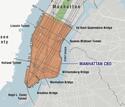This new report examines the housing crisis in California and strategies to create more housing at affordable price points. Below is a summary and a link to download the full report read more »
Planning
Report: How Will California Solve the Housing Crisis?
- Login to post comments
New Jersey Challenges New York’s Cordon Fee Plan
With federal approval of New York’s environmental assessment, most of the federal, state, and local obstacles to New York City’s cordon pricing plan — which almost everyone erroneously calls a congestion pricing plan read more »
Amtrak Carried 86% of Pre-Pandemic PM in May
Amtrak carried 492 million passenger-miles in May 2023, which was just 86.4 percent of the 569 million passenger-miles it carried in the same month of 2019, according to Amtrak’s latest read more »
- Login to post comments
To Reduce Costs, California Also Needs to Build New Suburbs
The three myths that have led to this predicament are the following: Nuclear power and natural gas power causes unacceptable harm to the environment; reservoirs and desalination plants cause unacceptable harm to the environment; and single-family homes nestled in sprawling suburbs cause unacceptable harm to the environment. read more »
- Login to post comments
If It’s “Livable,” You Can’t Afford It
North America’s most livable cities are also among the least affordable. At least, that’s my conclusion from the Economist‘s 2023 read more »
- Login to post comments
Solving the Global Housing Crisis
The global housing crisis across the high-income world, particularly in the Anglosphere, represents perhaps the single biggest challenge to the future of the middle class. read more »
- Login to post comments
Housing Report: Blame Ourselves, Not Our Stars
No issue plagues Californians more than the high cost of housing. By almost every metric—from rents to home prices—Golden State residents suffer the highest burden for shelter of any state in the continental U.S. read more »
- Login to post comments
The Once Lucky Country: Can It Be Again?
An introduction to this newly released report on demographics and economic mobility in Australia, prepared in collaboration with the Institute of Public Affairs, is read more »
- Login to post comments
By Failing to Promote Safety, America’s Older Cities are Failing to Build Community
It seems that a day hardly goes by without another incident of violence making the national news. From school shootings to aggressive protests from extreme groups and endless petty crime in general read more »
- Login to post comments
Cities Aren't Dying But They Do Face Challenges
You’ve probably seen photos or videos of huge homeless encampments in America’s cities, like the ones in this Daily Mail article about Portland. read more »
- Login to post comments






















